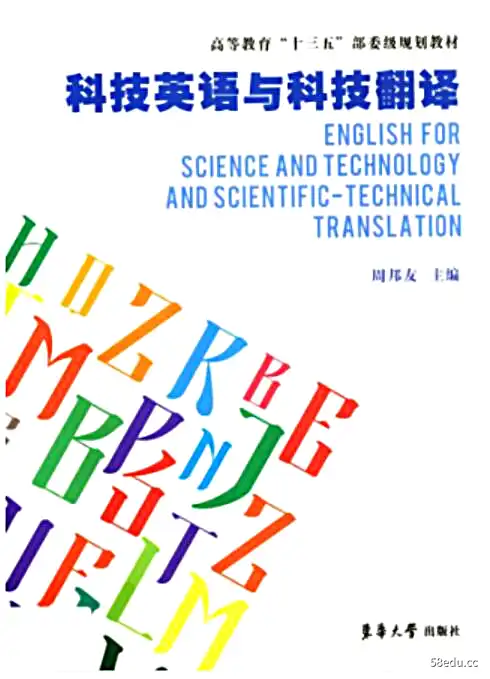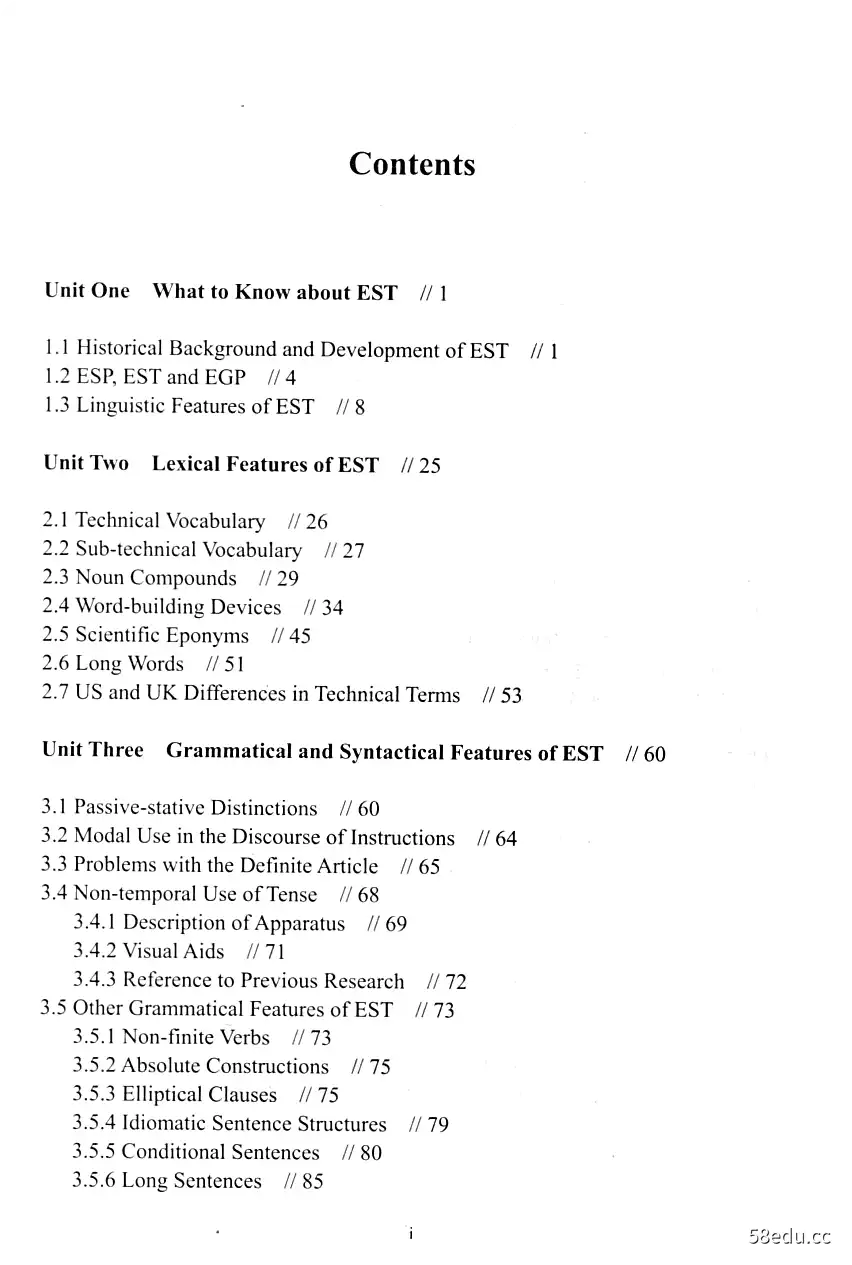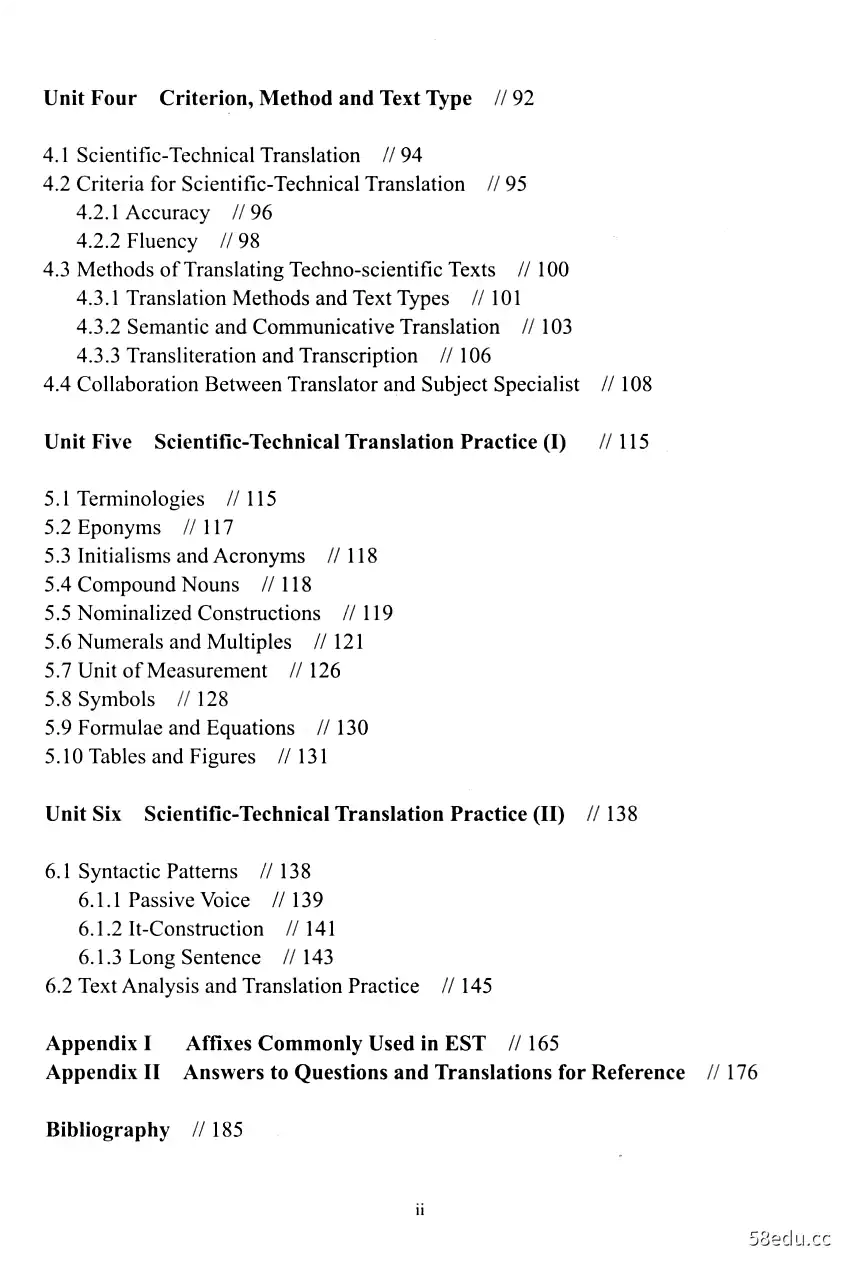《科技英语与科技翻译》周邦友主编|(pdf)电子书下载
图书名称:《科技英语与科技翻译》
- 【作 者】周邦友主编
- 【丛书名】高等教育“十三五”部委级规划教材
- 【页 数】 187
- 【出版社】 上海:东华大学出版社 , 2019.03
- 【ISBN号】978-7-5669-1547-4
- 【价 格】36.00
- 【分 类】科学技术-英语-翻译-教材
- 【参考文献】 周邦友主编. 科技英语与科技翻译. 上海:东华大学出版社, 2019.03.
图书封面:

图书目录:


《科技英语与科技翻译》内容提要:
拟编教材内容涉及上篇:科技英语与下篇:科技翻译。上篇阐述科技英语(EnglishforScienceandTechnology)的语言特质,包括与GeneralEnglish的差异比较、科技英语词汇特点、语法特点。下篇专论科技翻译(TranslationofScientificTexts),包括翻译标准、翻译方法、翻译实践。作者精心设计目录标题,选编的大量句型和段落,讲解简单。举例典型,既有理论也配用大量练习。可供教师讲课参考,学生及自学者学习、套用、模拟。
《科技英语与科技翻译》内容试读
Unit One What to Know about EST
Learning objectives
Upon completing this unit,the student should be able to:
●define EST
have an overview of the origins and development of EST;
O differentiate EST from general English;andknow about linguistic features of EST.
English for Science and Technology,called EST for short,is specialized Englishfor non-English speakers who are studying or working in scientific andtechnological fields.An EST text usually presents facts,hypotheses,and otherinstances of scientific and technical information.It is not concerned with the formsof written English that editorialize,express emotions or emotionally basedarguments or that are fictional or poetic in nature.That is,EST writing is the typeof discourse that has as its purpose the transmission of information (fact orhypothesis)from writers to readers;therefore it is used only a limited number ofrhetorical functions.It does not,for example,use such rhetorical functions aseditorializing,non-logical argumentation,poetic images,or those functions thatcreate emotions such as laughter,sadness,etc.
As it has turned out,English has become the accepted international language ofscience,technology and commerce as enormous and unprecedented expansion inscientific,technical and economic activity on an international scale.English,therefore,creates a new generation of learners who know specifically why they arelearning it:businessmen and-women who want to sell their products,mechanicswho have to read instruction manuals,doctors who need to keep up withdevelopments in their field and students whose prospective work would be relatedto science and technology.The large-scale international scientific,technical andeconomic developments after World War II,requested for an internationallanguage to serve the needs and demands of people.That language is English andit is needed to update people's knowledge or simply do their work in a global labormarket.Hence,there are made many attempts to focus on ESP (English for
Specific Purposes)and EST.
1.1 Historical Background and Development of EST
English for Science and Technology or EST as one of English learners'courses is
1
the product of the revolution in linguistics.At the same time as the demand wasgrowing for English courses tailored to specific needs,influential new ideas beganto emerge in the study of language.Traditionally,linguistics aimed at describingthe rules of English usage,namely,the grammar.However,the new studies shiftedattention away from defining the formal features of language usage to discoveringthe ways in which language is actually used in real communication (Widdowson1978).One finding of these studies was that the language we speak and writevaries considerably,and in a number of different ways,from one context toanother.In English teaching this gave rise to the view that there are significantdifferences between,say,the English of commerce and that of engineering.Theseideas married up naturally with the development of English courses for specificgroups of learners (Hutchinson Waters 1987:7).Then came the studies onEnglish for Science and Technology.
The history of the EST research can be traced back to the 1960s.C.L.Barber isone of the pioneers in this research.He published the article On the Nature of
Scientific English as early as 1962.And it was the late 1960s and early 1970s thatsaw the greatest expansion of research into the nature of particular varieties of
English,say,descriptions of written scientific and technical English by Ewer and
Latorre (1969),Swales (1971),Selinker and Trimble (1976)and others.Most ofthe work at this time was in the area of English for Science and Technology andfor a time English for Specific Purposes (ESP)and EST were regarded as almostsynonymous(Hutchinson Waters 1987:7).But there were studies in other fieldstoo,such as the analysis of doctor-patient communication by Candlin,Bruton and
Leather (1976).
Generally there are important phases in the history and development of the ESTmovement.The first phase covers the 1960s and 1970s,when teaching ESTfocused on the sentence level with the focus laid on the so-called"need analysis".
And the need analyses that were carried out mainly concentrated on the lexical andgrammatical features of professional registers,such as the language of engineeringor the language of medical studies.Researchers discovered,among the moststriking peculiarities of EST,for instance,the extensive use of simple present tense,of passive constructions and of noun compounds."After careful analyses ofidentified spoken or written discourse,practitioners organized theirgrammar-based curricula around the features of these special registers.One of themost famous volumes to appear during this period was Swales's Writing Scientific
English(1971),where chapters are based principally upon the grammatical formsmost commonly found in the scientific English register."(Celce-Murcia 1991:68)
The late 1970s and early 1980s brought about the second phase in the career ofEST,in which the sentence level analysis and the focus on grammatical formsstarted to integrate rhetorical functions as well.Tarone,Dwyer,and Gillette werepioneers of rhetorical analysis in EST.Tarone et.al.(1981)published a researchthat was intended to examine the function and frequency of passive voice withinastrophysics.When comparing the functions of passive structures in theseastrophysics journal articles with active voice,they practically performed arhetorical analysis,stating that passive voice was used by the scientists/authors ofthe articles when "a.they are following established procedures rather thandiscussing their own procedural choices,b.they are discussing others'work incontrast to their own,c.they are referring to their own future research,or d.theywish to front (i.e.topicalize)certain information in sentences."(Celce-Murcia1991:68-69)Thus,in this second phase the focus of register analysis became morerhetorical,and when talking about understanding language use in EST,morecounting of grammatical and/or lexical features was not enough any longer.
The third phase of the evolution of EST integrated the discoveries of the previoustwo phases (linguistic features and rhetorical elements),as the focus was on thetarget situation and the oral communication students might need in differentprofessional contexts,which led to the implementation of so-called"notional-functional curriculum".The main pillars of this notional-functionalapproach were:the communicative purposes (or functions)of the speaker,thesetting for language use and the mode of communication,and the keyword of thewhole approach is the functional nature of communication."Therefore in
Notional-Functional Syllabuses,instead of having textbook units which areorganized grammatically (as in Phase 1),such as The Present Perfect,or whichconsider the purposes of written discourse(e.g.Article Introductions),as in Phase2,there are chapter headings such as Agreeing and Disagreeing.Within thechapters,students are provided with sample dialogues taking place in differentcontexts among different people,thereby exemplifying the language use whichrealizes a speaker's communicative purposes within a specified context."(Celce-Murcia 1991:70)As Robinson(1991:23)points out:
Earlier studies focused on elements of the sentence and their construction;latercohesion(particularly grammatical cohesion)was an important consideration.
Attention then moved to the meanings of forms(notions and functions)ratherthan their structure and to the study of forms in context.
3
The fourth phase started in the second half of the 1980s,which was influenced bypsycholinguistics.If earlier the focus had been on the discourse and itsgrammatical features,on the communicative situation or the communicativepurpose,now the attention shifted to the strategies used by learners to acquire thelanguage.Hutchinson and Waters(1987)were the first who claimed that the needanalyses had to include issues like the measurement of the learners'existingknowledge,their interest in the materials presented,the learners'modalities ofstoring and retrieving information and their active involvement in curriculumdesign.
More recently,lexicographers and terminologists have started to focus less ondidactic aspects and more on the problem of specialized languages,this time themain question being not necessarily how to teach specialized languages,but whatsuch languages look like.Raquel Martinez Motos (2013)seems to opt for a newterm,Academic and Professional Languages,a term created and introduced by
Alcaraz in his article "Academic and Professional English"(2000).And the firstdecade of the 2000s can be called the society of knowledge,as "one of thedefining features of this society in interdisciplinarity....And it is also characterizedby a tendency toward specialization.As a result,both interdisciplinarity andspecialization have a great impact on what has been named as Academic and
Professional Languages."(Motos 2013:4)
1.2 ESP,EST and EGP
According to Hutchinson Waters (1987:16),ESP in the tree of English
Language Teaching(ELT)in fact consists of three branches:i)English for Scienceand Technology (EST),ii)English for Business and Economics(EBE),and iii)English for Social Studies(ESS).Each of these subject areas is further divided intotwo branches:English for Academic Purpose(EAP)and English for Occupational
Purpose(EOP).An example of EOP for the EST branch is"English for Engineers"whereas an example of EAP for the EST branch is "English for Medical Studies".
They hold that ESS is not common,for it is not thought to differ significantly frommore traditional humanities-based General English.See Figure 1-1 The Tree of
ELT.
English forEnglish
English for
English for
English
English for
EAP Courses
OccuDational
EOP
Purposes
stud
English for
nent
EOP)
EAP
EAP
EOp is also known as
Enalish for
EVP (English for
Busihess and
English for
English for
Economics
English as a
Social ciences
ana
EBE)
ESS)
Adutt
Tertiary
English for
Specific
US:High School)
Primary
ESP
exam purposes
General
Enolish
9E)
ESL can bedivided in
English as a
the same wayas EFL
Foreign Language
as a
EFL
EMT)
8品8age
ESL
h
nquage
(ELT)
In American ELT
the dominantbranch is ESL
EARNIN
Figure 1-1 The Tree of ELT(Hutchinson Waters 1987:17)
Swales (1985:x)in fact uses the development of EST to illustrate the developmentof ESP in general:
EST is the senior branch of ESP -senior in age,larger in volume of publicationsand greater in number of practitioners employed.[..With one or two exceptions,English for Science and Technology has always set and continues to set the trend in
5
theoretical discussion,in ways of analyzing language,and in the variety of actualteaching materials.
ESP is the English language taught for professional,vocational,and otherspecified purposes.Originating in courses of Business English for foreign learners,ESP developed in the 1960s in response to demands for courses geared to practicaland functional rather than educational and cultural ends.ESP,in general,addresseslearners with a common reason for learning,such as the English of air trafficcontrol or that of dyestuff chemistry.That is,ESP is generally designed to meetspecific needs of the learners,especially for intermediate or advanced students.Itmakes use of underlying methodology and activities of the discipline it serves;it iscentered on the language appropriate to these activities in terms of grammar,lexis,register,study skills,discourse and genre.
EST is now and widely viewed as a sub-branch of ESP.To put it another way,ESTis a sub category of the larger field of English for Specific Purposes in which itshares some basic characteristics with the larger field of ESP.EST emphasizespurposeful and utilitarian learning of English,and it covers the areas of Englishwritten for academic and professional purposes and of English written foroccupational (and vocational)purposes,including the often informally writtendiscourse found in trade journals and in scientific and technical materials writtenfor laymen.EST mainly deals with learners at the tertiary level for whom thelearning of English takes on a service role for their specific needs in study,work orresearch.
Both ESP and EST may use,in specific situations,a different methodology fromthat of General English.
General English can be referred not only to a semi-technical term for Englishwhen the language at large is contrasted with a usage,variety,dialect,or registerand to a semi-technical term for a course in English within a framework of generaleducation,usually teaching listening,speaking,reading and writing,but also toEnglish for General Purposes(EGP),a term in language teaching for a broadlybased,usually long-term EFL or ESL course,in contrast to English for Specific
Purposes (Business English,English for Medical Purposes,etc.).As we go downthe tree,we can see that GE is usually studied for exam purposes.
Since scientists and technologists attempt to be impersonal and objective indescribing natural phenomena and facts,their discoveries (processes and
6
···试读结束···
作者:资源君
链接:https://www.xuexizoo.com/article/1759808063168069895.html
文章版权归作者所有,未经允许请勿转载。如有侵权,请发邮件联系管理员进行处理,邮箱地址:121671486@qq.com